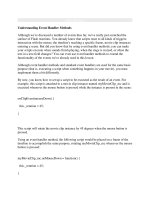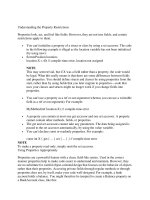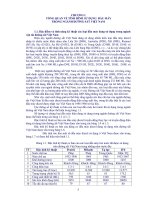Tài liệu Understanding Automotive Electronics P1 ppt
Bạn đang xem bản rút gọn của tài liệu. Xem và tải ngay bản đầy đủ của tài liệu tại đây (1020.51 KB, 30 trang )
Understanding
Automotive
Electronics
2735 | FM Page i Tuesday, March 10, 1998 10:49 AM
2735 | FM Page ii Tuesday, March 10, 1998 10:49 AM
Understanding
Automotive
Electronics
Fifth Edition
By:
William B. Ribbens, Ph.D.
With
Contributions
to Previous
Editions
by:
Norman P. Mansour
Gerald Luecke
Charles W. Battle
Edward C. Jones
Leslie E. Mansir
Newnes
Boston, Oxford, Johannesburg, Melbourne, New Delhi, Singapore
2735 | FM Page iii Tuesday, March 10, 1998 10:49 AM
Newnes is an imprint of Butterworth–Heinemann.
Copyright © 1998 by Butterworth–Heinemann
A member of the Reed Elsevier group
All rights reserved.
No part of this publication may be reproduced, stored in a retrieval system, or
transmitted in any form or by any means, electronic, mechanical, photocopying,
recording, or otherwise, without the prior written permission of the publisher.
Recognizing the importance of preserving what has been written, Butterworth–
Heinemann prints its books on acid-free paper whenever possible.
Butterworth–Heinemann supports the efforts of American Forests
and the Global ReLeaf program in its campaign for the betterment of
trees, forests, and our environment.
ISBN 0-7506-7008-8
The publisher offers special discounts on bulk orders of this book.
For information, please contact:
Manager of Special Sales
Butterworth–Heinemann
225 Wildwood Avenue
Woburn, MA 01801–2041
Tel: 781-904-2500
Fax: 781-904-2620
For information on all Butterworth–Heinemann publications available, contact
our World Wide Web home page at: />10987654321
Printed in the United States of America
2735 | FM Page iv Tuesday, March 10, 1998 10:49 AM
To Katherine
2735 | FM Page v Tuesday, March 10, 1998 10:49 AM
2735 | FM Page vi Tuesday, March 10, 1998 10:49 AM
UNDERSTANDING AUTOMOTIVE ELECTRONICS
vii
Contents
Preface
ix
Chapter 1 Automotive Fundamentals 1
Quiz 27
Chapter 2 The Systems Approach to Control and Instrumentation 29
Quiz 69
Chapter 3 Electronics Fundamentals 71
Quiz 96
Chapter 4 Microcomputer Instrumentation and Control 99
Quiz 144
Chapter 5 The Basics of Electronic Engine Control 147
Quiz 183
Chapter 6 Sensors and Actuators 187
Quiz 221
Chapter 7 Digital Engine Control System 223
Quiz 258
Chapter 8 Vehicle Motion Control 261
Quiz 294
Chapter 9 Automotive Instrumentation 297
Quiz 332
Chapter 10 Diagnostics 335
Quiz 365
Chapter 11 Future Automotive Electronic Systems 367
Quiz 406
Glossary
409
Index
415
Answers to Quizzes.
433
2735 | FM Page vii Tuesday, March 10, 1998 10:49 AM
2735 | FM Page viii Tuesday, March 10, 1998 10:49 AM
UNDERSTANDING AUTOMOTIVE ELECTRONICS
ix
Preface
Since the introduction of electronics for emission control on engines, the
evolution of electronics in automobiles has advanced rapidly. The pace of
development has inspired four revisions of this book in roughly ten years to
avoid obsolescence. Rarely in history have technical developments moved at
such a pace.
Electronics have recently been incorporated on new automotive
subsystems and have become standard implementation on many others. Such
features as antilock braking systems and airbags could only be achieved
practically through the use of electronics. These features are rapidly becoming
standard features owing to strong pressures in the highly competitive North
American automotive market.
The first edition of this book was devoted primarily to electronic engine
control because this was the chief application at that time. A number of
automotive systems which were discussed in the chapter on the future of
automotive electronics in the second, third, and fourth editions are now in
production. These systems are presented in the appropriate chapters of this
fifth edition. This latest edition covers most of the automotive subsystems
incorporating electronics except for entertainment systems. These systems
have been omitted partly due to space limitations and because automotive
entertainment systems are closely related to home entertainment systems,
which are discussed in many excellent publications.
In its revised form, this book explains automotive electronics as of the late
1990s. It should prepare the reader for an understanding of present as well as
future developments in this field into at least the early part of the next century.
William B. Ribbens
November 1997
2735 | FM Page ix Tuesday, March 10, 1998 10:49 AM
2735 | FM Page x Tuesday, March 10, 1998 10:49 AM
Understanding
Automotive
Electronics
2735 | FM Page xi Tuesday, March 10, 1998 10:49 AM
2735 | FM Page xii Tuesday, March 10, 1998 10:49 AM
AUTOMOTIVE FUNDAMENTALS
1
UNDERSTANDING AUTOMOTIVE ELECTRONICS
1
Automotive Fundamentals
Picture yourself in the not-too-distant future driving your new car
along a rural interstate highway on a business trip. The cruise control is
maintaining the speed at a steady 100 km/hr (62 mph) and there is relatively
little traffic. As you approach a slower car, the speed-control system slows
your car to match the speed of the slower car and maintain a safe distance of
about 53 m (165 ft) behind the slowe/r car. When oncoming traffic clears,
you enter the passing lane and your car automatically increases speed as you
pass the slower car.
You press a button on the steering column and an image of a road map
appears faintly visible (so as not to obscure the road ahead) on the windshield in
front of you. This map shows your present position and the position of the
destination city. The distance to your destination and the approximate arrival
time are displayed on the digital instrument cluster.
You are talking on your cellular phone to your office about some changes
in a contract that you hope to negotiate. After the instructions for the contract
changes are completed, a printer in your car generates a copy of the latest
contract version.
The onboard entertainment system is playing music for you at a
comfortable level relative to the low-level wind and road noise in the car. After
completing your phone conversation, you press another button on the steering
wheel and the music is replaced by a recorded lesson in French verb
conjugation, which you have been studying. Suddenly, the French lesson is
interrupted by a message delivered in natural-sounding synthesized speech.
“You have fuel remaining for another 50 miles at the present speed. Your
destination is 23 miles away. Recommend refueling after exiting the highway.
There is a station that accepts your electronic credit near the exit (you know, of
course, that the electronic credit is activated by inserting the fuel nozzle into the
car). Also, the left rear tire pressure is low and the engine control system reports
that the mass air flow sensor is intermittently malfunctioning and should be
serviced soon.’’ After this message has been delivered, the French lesson returns.
A short time later, the French lesson is again interrupted by the electronic
voice message system: “Replace the disk in the Navigation CD player with disk
number 37 for detailed map and instructions to your destination, please.’’ Then
the French lesson returns.
You insert the correct disk in the Navigation CD player as requested
and the map display on the windshield changes. The new display shows a
detailed map of your present position and the route to your destination. As
2735 | CH 1 Page 1 Tuesday, March 10, 1998 10:52 AM
1
AUTOMOTIVE FUNDAMENTALS
2
UNDERSTANDING AUTOMOTIVE ELECTRONICS
you approach the city limits, the car speed is automatically reduced to the
legal limit of 55 mph. The voice message system speaks again: “Leave the
highway at exit 203, which is one-half mile away. Proceed along Austin Road
to the second intersection, which is Meyer Road. Turn right and proceed 0.1
mile. Your destination is on the right-hand side of the road. Don’t forget to
refuel.’’
This scenario is not as farfetched as it sounds. All of the events
described are technically possible. Some have even been tested experimentally.
The electronic technology required to develop a car with the features
described exists today. The actual implementation of such electronic features
will depend on the cost of the equipment and the market acceptance of the
features.
USE OF ELECTRONICS IN THE AUTOMOBILE
Microelectronics will
provide many exciting
new features for auto-
mobiles.
Electronics have been relatively slow in coming to the automobile
primarily because of the relationship between the added cost and the benefits.
Historically, the first electronics (other than radio) were introduced into the
commercial automobile during the late 1950s and early 1960s. However, these
features were not well received by customers, so they were discontinued from
production automobiles.
Environmental regula-
tions and an increased
need for economy have
resulted in electronics
being used within a
number of automotive
systems.
Two major events occurred during the 1970s that started the trend
toward the use of modern electronics in the automobile: (1) the introduction of
government regulations for exhaust emissions and fuel economy, which
required better control of the engine than was possible with the methods being
used; and (2) the development of relatively low cost per function solid-state
digital electronics that could be used for engine control.
Electronics are being used now in the automobile and probably will be
used even more in the future. Some of the present and potential applications
for electronics are
1. Electronic engine control for minimizing exhaust emissions and maximiz-
ing fuel economy
2. Instrumentation for measuring vehicle performance parameters and for
diagnosis of on-board system malfunctions
3. Driveline control
4. Vehicle motion control
5. Safety and convenience
6. Entertainment/communication/navigation
Many of these applications of electronics will be discussed in this book.
CHAPTER OVERVIEW
This chapter will give the reader a general overview of the automobile
with emphasis on the basic operation of the engine, thus providing the reader
with the background to see how electronic controls have been and will be
2735 | CH 1 Page 2 Tuesday, March 10, 1998 10:52 AM
AUTOMOTIVE FUNDAMENTALS
1
UNDERSTANDING AUTOMOTIVE ELECTRONICS
3
applied. The discussion is simplified to provide the reader with just enough
information to understand automotive mechanics. Readers who want to know
the mechanics of an automobile in more detail are referred to the many books
written for that purpose.
THE AUTOMOBILE PHYSICAL CONFIGURATION
The earliest automobiles consisted of carriages (similar to those drawn by
horses) to which a primitive engine and drivetrain and steering controls were
added. Typically, such cars had a strong steel frame that supported the body of
the car. The wheels were attached to this frame by a set of springs and shock
absorbers that permitted the car to travel over the uneven road surfaces of the
day while isolating the car body from much of the road irregularities. This same
general configuration persisted in most passenger cars until some time after
World War II, although there was an evolution in car size, shape, and features as
technology permitted.
This early configuration is depicted in Figure 1.1, in which many of the
important automotive systems are illustrated. These systems include the
following:
1. Engine
2. Drivetrain (transmission, differential, axle)
3. Suspension
4. Steering
5. Brakes
6. Instrumentation
7. Electrical/electronic
8. Motion control
9. Comfort/convenience
10. Entertainment/communication/navigation
In Figure 1.1 the frame or chassis on which the body is mounted is
supported by the suspension system. The wheels’ brakes are connected to the
opposite end of the suspension components. The steering and other major
mechanical systems are mounted on one of these components and attached as
necessary through mechanical components to other subsystems.
This basic vehicle configuration was used from the earliest cars through
the late 1960s or 1970s, with some notable exceptions. The increasing
importance of fuel efficiency and government-mandated safety regulations led
to major changes in vehicle design. The body and frame evolved into an
integrated structure to which the power train, suspension, wheels, etc., were
attached.
Once again with a few notable exceptions, most cars had an engine in front
configuration with the drive axle at the rear. While it is an advantage for several
reasons (e.g., crash protection, efficient engine cooling) to have the engine in front,
this location has a disadvantage from a traction standpoint. Because the engine is a
2735 | CH 1 Page 3 Tuesday, March 10, 1998 10:52 AM
1
AUTOMOTIVE FUNDAMENTALS
4
UNDERSTANDING AUTOMOTIVE ELECTRONICS
relatively heavy component, its location influences weight distribution (fore and
aft).
Ideally, the engine should be located near the drive wheels for optimal
drive traction. It is this fact that has led car makers to configure the front wheels
as drive wheels. This change has led to the engine being mounted transversely
(i.e., with the rotation axis orthogonal to the vehicle axis as opposed to along
the vehicle axis). In automotive parlance the traditional engine orientation is
referred to as
North-South,
and the transverse orientation as
East-West
. The
transmission is mounted adjacent to the engine and oriented with its axis
parallel to the engine axis. The differential and drive axle configuration is
normally mounted in the transmission; the combined unit is thus called the
transaxle
.
For stability purposes the steering is still via the front wheels. The
combination of steering and drive mechanisms results in a somewhat more
complicated front-wheel system configuration than the traditional orientation.
Figure 1.1.
Systems of the
Automobile
FPO
2735 | CH 1 Page 4 Tuesday, March 10, 1998 10:52 AM
AUTOMOTIVE FUNDAMENTALS
1
UNDERSTANDING AUTOMOTIVE ELECTRONICS
5
Evolution of Electronics in the Automobile
This book explores the application of modern solid-state electronics to
the various automotive subsystems described above. Apart from auto radios,
some turn signal models, and a few ignition systems, there was very little use
of electronics in the automobile until the early 1970s. Government-mandated
emission regulations, fuel economy, and safety requirements motivated the
initial use of electronics. The dramatic performance improvements and
relatively low cost of electronics have led to an explosive application of
electronics in virtually every automotive subsystem. We will be exploring these
electronic systems in great detail later in this book, but first it is helpful to
review the basic mechanical configurations for each component and
subsystem.
THE ENGINE
The engine in an automobile provides all the power for moving the
automobile, for the hydraulic and pneumatic systems, and for the electrical
system. A variety of engine types have been produced, but one class of engine is
used most: the internal combustion, piston-type, 4-stroke/cycle, gasoline-
fueled, spark-ignited, liquid-cooled engine. This engine will be referred to in
this book as the spark-ignited, or SI, engine.
Although rapid technological advances in the control of the SI engine
have been achieved through the use of electronics, the fundamental mechanical
configuration has remained unchanged since this type of power plant was first
invented. In addition, the introduction of modern materials has greatly
improved the packaging, size, and power output per unit weight or per unit
volume. In order that the reader may fully appreciate the performance
improvements that have been achieved through electronic controls, we illustrate
the engine fundamentals with an example engine configuration from the pre-
electronic era.
Figure 1.2 is a partial cutaway drawing of an SI engine configuration
commonly found in the period immediately following World War II. The
engine there illustrated is a 6-cylinder, overhead-valve, inline engine. An engine
of this configuration is rarely found in present-day cars. Rather, a more
common engine configuration today would be either a 4-cylinder inline or a V-
type engine with either 6 or 8 cylinders (although there are exceptions).
Moreover, the materials found in present-day engines permit greatly reduced
weight for a given engine power.
Nevertheless, modern electronically controlled engines have much in
common with this example configuration. For example, the vast majority of
modern engines are 4-stroke/cycle, gasoline fueled, spark ignited, and water
cooled. By illustrating the fundamentals of engine operation using the example
engine of Figure 1.2, we can thus explain the differences that have occurred
with modern electronic controls.
2735 | CH 1 Page 5 Tuesday, March 10, 1998 10:52 AM
1
AUTOMOTIVE FUNDAMENTALS
6
UNDERSTANDING AUTOMOTIVE ELECTRONICS
The major components of the engine include the following:
1. Engine block
2. Cylinder
3. Crankshaft
4. Pistons
5. Connecting rods
6. Camshaft
7. Cylinder head
8. Valves
9. Fuel control system
10. Ignition system
11. Exhaust system
12. Cooling system
Electronics play a direct role in only the fuel control, ignition, and exhaust
systems. It will be shown in Chapters 5, 6, and 7 that in order to meet
government regulations for exhaust emissions and fuel economy, these systems
combine to optimize performance within regulatory constraints. In the earliest
days of government regulation, electronic controls were applied to existing
engine designs. However, as electronic technology evolved, the engine
mechanical configuration was influenced (at least indirectly) by the electronic
controls that were intended to be applied.
Figure 1.2
Cutaway View of a 6-
Cylinder, Overhead-
Valve, Inline Engine
(Source: Crouse)
FPO
2735 | CH 1 Page 6 Tuesday, March 10, 1998 10:52 AM
AUTOMOTIVE FUNDAMENTALS
1
UNDERSTANDING AUTOMOTIVE ELECTRONICS
7
Engine Block
Conventional internal
combustion engines
convert the movement
of pistons to the rota-
tional energy used to
drive the wheels.
The cylinders are cast in the engine block and machined to a smooth
finish. The pistons fit tightly into the cylinder and have rings that provide a
tight sliding seal against the cylinder wall. The pistons are connected to the
crankshaft by connecting rods, as shown in Figure 1.3. The crankshaft converts
the up and down motion of the pistons to the rotary motion needed to drive
the wheels.
Cylinder Head
The cylinder head contains an intake and exhaust valve for each cylinder.
When both valves are closed, the head seals the top of the cylinder while the
piston rings seal the bottom of the cylinder.
The valves are operated by off-center (eccentric) cams on the camshaft,
which is driven by the crankshaft as shown in Figure 1.4. The camshaft rotates
at exactly half the crankshaft speed because a complete cycle of any cylinder
involves two complete crankshaft rotations and only one sequence of opening
and closing of the associated intake and exhaust valves. The valves are normally
held closed by powerful springs. When the time comes for a valve to open, the
lobe on the cam forces the pushrod upward against one end of the rocker arm.
The other end of the rocker arm moves downward and forces the valve open.
(Note: Some engines have the camshaft above the head, eliminating the
pushrods. This is called an
overhead cam
engine.)
Figure 1.3
Piston Connection to
Crankshaft (Source:
Crouse)
FPO
2735 | CH 1 Page 7 Tuesday, March 10, 1998 10:52 AM
1
AUTOMOTIVE FUNDAMENTALS
8
UNDERSTANDING AUTOMOTIVE ELECTRONICS
The 4-Stroke Cycle
Conventional SI engines
operate using four
“strokes,” with either an
up or down movement
of each piston. These
strokes are named
intake, compression,
power,
and
exhaust
.
The operation of the engine can be understood by considering the actions
in any one cylinder during a complete cycle of the engine. One complete cycle
in the 4-stroke/cycle SI engine requires two complete rotations of the
crankshaft. As the crankshaft rotates, the piston moves up and down in the
cylinder. In the two complete revolutions of the crankshaft that make up one
cycle, there are four separate strokes of the piston from the top of the cylinder
to the bottom or from the bottom to the top. Figure 1.5 illustrates the four
strokes for a 4-stroke/cycle SI engine, which are called:
1. Intake
2. Compression
3. Power
4. Exhaust
There are two valves for each cylinder. The left valve in the drawing is
called the
intake valve
and the right valve is called the
exhaust valve.
The intake
valve is normally larger than the exhaust valve. Note that the crankshaft is
assumed to be rotating in a clockwise direction. The action of the engine during
the four strokes is described in the following sections.
Figure 1.4
Valve Operating
Mechanism (Source:
Crouse)
FPO
2735 | CH 1 Page 8 Tuesday, March 10, 1998 10:52 AM
AUTOMOTIVE FUNDAMENTALS
1
UNDERSTANDING AUTOMOTIVE ELECTRONICS
9
I
ntake
During the intake stroke (Figure 1.5a), the piston is moving from top to
bottom and the intake valve is open. As the piston moves down, a partial
vacuum is created, which draws a mixture of air and vaporized gasoline through
the intake valve into the cylinder.
It will be shown in Chapters 5, 6, and 7 that, in modern, electronically
controlled engines, fuel is injected into the intake port and is timed to coincide
with the intake stroke. The intake valve is closed after the piston reaches the
bottom. This position is normally called
bottom dead center
(BDC).
Compr
ession
During the compression stroke (Figure 1.5b), the piston moves upward
and compresses the fuel and air mixture against the cylinder head. When the
piston is near the top of this stroke, the ignition system produces an electrical
spark at the tip of the spark plug. (The top of the stroke is normally called
top
dead center
—TDC). The spark ignites the air–fuel mixture and the mixture
burns quickly, causing a rapid rise in the pressure in the cylinder.
Figure 1.5
The Four Strokes of a
Typical Modern
Gasoline-Fueled,
Spark-Ignition Engine
FPO
2735 | CH 1 Page 9 Tuesday, March 10, 1998 10:52 AM
1
AUTOMOTIVE FUNDAMENTALS
10
UNDERSTANDING AUTOMOTIVE ELECTRONICS
P
ower
During the power stroke (Figure 1.5c), the high pressure created by the
burning mixture forces the piston downward. It is only during this stroke that
actual usable power is generated by the engine.
E
xhaust
During the exhaust stroke (Figure 1.5d), the piston is again moving
upward. The exhaust valve is open and the piston forces the burned gases from
the cylinder through the exhaust port into the exhaust system and out the
tailpipe into the atmosphere.
Each piston on a
4-stroke SI engine pro-
duces actual power dur-
ing just one out of four
strokes.
This 4-stroke cycle is repeated continuously as the crankshaft rotates. In a
single-cylinder engine, power is produced only during the power stroke, which
is only one-quarter of the cycle. In order to maintain crankshaft rotation during
the other three-quarters of the cycle, a flywheel is used. The flywheel has
traditionally been a relatively large, heavy, circular object that is connected to
the crankshaft, although in modern engines the mass of the flywheel has been
reduced relative to very early engines. The primary purpose of the flywheel is to
provide inertia to keep the crankshaft rotating during the three non-power-
producing strokes of the piston.
In a multicylinder engine, the power strokes are staggered so that power is
produced during a larger fraction of the cycle than for a single-cylinder engine.
In a 4-cylinder engine, for example, power is produced almost continually by
the separate power strokes of the four cylinders. The shaded regions of Figure
1.6 indicate which cylinder is producing power for each 180 degrees of
crankshaft rotation. (Remember that one complete engine cycle requires two
complete crankshaft rotations of 360 degrees each, for a total of 720 degrees.)
Figure 1.6
Power Pulses From a
4-Cylinder Engine
FPO
2735 | CH 1 Page 10 Tuesday, March 10, 1998 10:52 AM
AUTOMOTIVE FUNDAMENTALS
1
UNDERSTANDING AUTOMOTIVE ELECTRONICS
11
ENGINE CONTROL
Control of the engine in any car means regulating the power that it
produces at any time in accordance with driving needs. The driver controls
engine power via the accelerator pedal, which, in turn, determines the setting of
the throttle plate via a mechanical linkage system. The throttle plate is situated
in the air intake system (Figure 1.7). The intake system is an assembly of pipes or
passageways through which the air flows from outside into each cylinder. The air
flowing into the engine flows past the throttle plate, which, in fact, controls the
amount of air being drawn into the engine during each intake stroke.
As we will show in later chapters, the power produced by the engine is
proportional to the mass flow rate of air into the engine. The driver then controls
engine power directly by controlling this air mass flow rate with the throttle plate.
Of course, the power produced by the engine depends on fuel being
present in the correct proportions. Air combines with fuel in the fuel metering
device. This device automatically delivers fuel in the correct amount as
determined by the air flow.
The classic fuel metering device was the carburetor, which is now virtually
obsolete. In modern car engines, fuel injectors do the fuel metering. The
amount of fuel delivered by a fuel injector is determined electronically in
Figure 1.7
Intake Manifold and
Fuel Metering
FPO
2735 | CH 1 Page 11 Tuesday, March 10, 1998 10:52 AM
1
AUTOMOTIVE FUNDAMENTALS
12
UNDERSTANDING AUTOMOTIVE ELECTRONICS
accordance with the air flow in such a way as to minimize pollutants in the
exhaust gas (see Chapter 5).
IGNITION SYSTEM
To produce power, the gasoline engine must not only have a correct
mixture of fuel and air, but also some means of initiating combustion of the
mixture. Essentially the only practical means is with an electric spark produced
across the gap between a pair of electrodes of a spark plug. The electric arc or
spark provides sufficient energy to cause combustion. This phenomenon is
called
ignition
.
Once a stable combustion has been initiated, there is no further need for
the spark. Typically, the spark must persist for a period of about a millisecond
(one thousandth of a second). This relatively short period makes spark ignition
possible using highly efficient pulse transformer circuits in which a circuit
having a relatively low average current can deliver a very high-voltage (high
peak power) pulse to the spark plug.
The ignition system itself consists of several components: the spark plug,
one or more pulse transformers (typically called
coils
), timing control circuitry,
and distribution apparatus that supplies the high-voltage pulse to the correct
cylinder.
Spark Plug
The spark is produced by applying a high-voltage pulse of from 20 kV to
40 kV (1 kV is 1,000 volts) between the center electrode and ground. The
actual voltage required to start the arc varies with the size of the gap, the
compression ratio, and the air–fuel ratio. Once the arc is started, the voltage
required to sustain it is much lower because the gas mixture near the gap
becomes highly ionized. (An ionized gas allows current to flow more freely.)
The arc is sustained long enough to ignite the air–fuel mixture.
A typical spark plug configuration is shown in Figure 1.8. The spark plug
consists of a pair of electrodes, called the
center
and
ground electrodes,
separated by
a gap. The gap size is important and is specified for each engine. The gap may be
0.025 inch (0.6 mm) for one engine and 0.040 inch (1 mm) for another engine.
The center electrode is insulated from the ground electrode and the metallic shell
assembly. The ground electrode is at electrical ground potential because one
terminal of the battery that supplies the current to generate the high-voltage pulse
for the ignition system is connected to the engine block and frame.
High-Voltage Circuit and Distribution
The ignition system provides the high-voltage pulse that initiates the arc.
Figure 1.9 is a schematic of the electrical circuit for the ignition system. The
high-voltage pulse is generated by inductive discharge of a special high-voltage
transformer commonly called an
ignition coil.
The high-voltage pulse is
delivered to the appropriate spark plug at the correct time for ignition by a
distribution circuit.
2735 | CH 1 Page 12 Tuesday, March 10, 1998 10:52 AM
AUTOMOTIVE FUNDAMENTALS
1
UNDERSTANDING AUTOMOTIVE ELECTRONICS
13
Figure 1.8
Spark Plug
Configuration
FPO
Figure 1.9
Schematic of the
Ignition Circuit
FPO
2735 | CH 1 Page 13 Tuesday, March 10, 1998 10:52 AM









